Fossils are found primarily in 3 types of sedimentary rock- shale, limestone, and sandstone.
Shale is either mudstone or a mixture of ancient mud and clay found at the bottom of calm bodies of water like lakes, swamps, and shallow seas like the Western Interior Seaway.
The shale splits easily into layers and within these layers very detailed carbon fossils are found. Some of the organisms fossilized in shale are plants, algae, brachiopods, and arthropods such as insects, crustaceans, centipedes, and spiders.
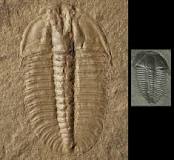
Burgess Shale
The Burgess Shale fossils of British Columbia, Canada are famous because the detailed remains of soft-bodied organisms like Opabinia and segmented worms were found.
Check out the interesting sea animals that were part of the Burgess Shale:
https://burgess-shale.rom.on.ca/en/science/burgess-shale/03-fossils.php
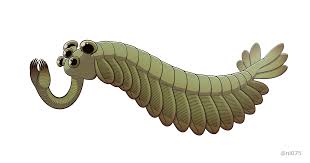
Picture from commons.wikimedia.org
Limestone is created in 2 ways.
1)Coral and shelled sea animals like clams and oysters were broken up by wave action, settled to the seafloor, and compressed together by water pressure.
2) Water that contains calcium carbonate particles (the mineral calcite)evaporated and left behind sediment that was also compacted by the pressure of the water.
Some of the fossils found in limestone coral, algae, crinoids, bivalves and brachiopods.
Fossiliferous limestone comes from a reef community and can be very detailed in individual fossils.
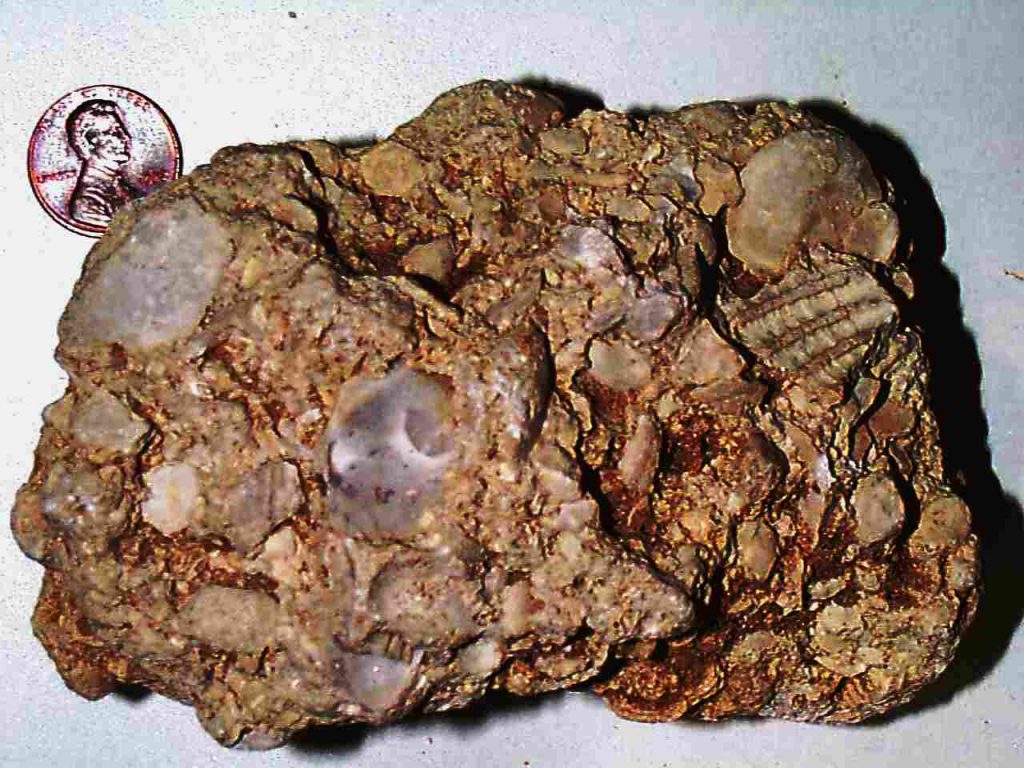
From itc.gsw.edu
Sandstone is made from sand-sized particles of minerals, rocks, and organic materials that have been weathered and transported to its place of deposition by water, wind, or ice. The sand in the stone is cemented with silt- or clay-sized particles that fill in the spaces in the sandstone.
Sandstone fossils are evidence of ancient beaches, deltas, dunes, sandbars, oceans, rivers, floodplains, and deserts.
Fossils in sandstone are not as detailed as limestone or shale but do tend to have delicate fossils including trace fossils like footprints and burrows.
Some of the fossils found in sandstone are trilobites, crustaceans, plants, mammoths, and dinosaurs.
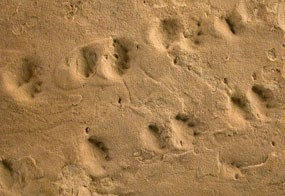
nps.gov
Volcanic ash and gases blasted from large eruptions create fast-moving pyroclastic flows in which fall-out can preserve what existed without completely burning and crushing. The ash enveloped and cemented the organisms in the positions in which they died. Mass mortality events like Pompeii and Nebraska’s Ashfall State Historical Fossil Beds are examples of the wealth of information that scientists can glean from volcanic ash fossils.
Near Royal, Nebraska, the ash encapsulated a water hole in which ancient barrel-bodied rhinos, llama-like camels, and 3-toed horses were enjoying their day 12 million years ago in what is now Ashfall State Historical Fossil Beds. The fossils here are very fragile so they are housed in a climate-controlled barn where they were found and partially excavated.
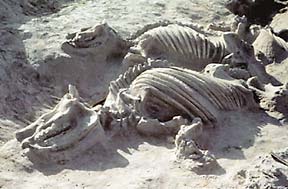
Ashfall Fossil Beds in Royal, Nebraska.
Asphalt, Bitumen, Pitch, or Tar forms when crude oil seeps to the surface through faults or cracks in the Earth’s crust. The lighter fraction of the oil will biodegrade or evaporate leaving the thicker oil fractions in sticky tar pools. Animals of all kinds, wood, plant remnants, dust, pollen, and microfossils have found their way into these pools, been preserved, and recovered in several places around the world.
California has many sites that still show active seeps and feature fossils preserved in these seeps.
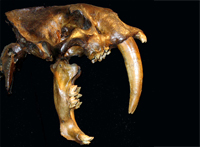
Saber-toothed Cat
1) Rancho La Brea (means ” the tar” in Spanish) Tar Pits in Los Angeles which has about 100 pits that are being excavated on site. A National Natural Landmark since 1962, La Brea has found 660 species of organisms so far!
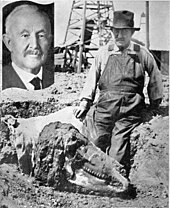
2) McKittrick Tar Pits -South of the town of McKittrick about 31 miles west of Bakersfield in Kern County in the southwestern part of the intersection between California State Routes 58 and 33. Stretching about 4 miles (6.5 Km), it is the most extensive asphalt lakes in California. It became a California Historical Landmark in 1952.
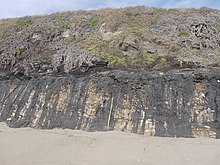
The ruler is 1 meter.
3) Carpinteria Tar Pits lies within the town of Carpinteria’s State Beach 12 miles (20 km) southeast of Santa Barbara.
Pitch Lake is the largest asphalt lake in the world. It is located near the town of La Brea on the Caribbean island of Trinidad of the dual-nation Trinidad and Tobago near Venezuela. It covers 100 acres(40 hectares) to a depth of 250 feet (~76 meters) and contains 100 million tons of asphalt.
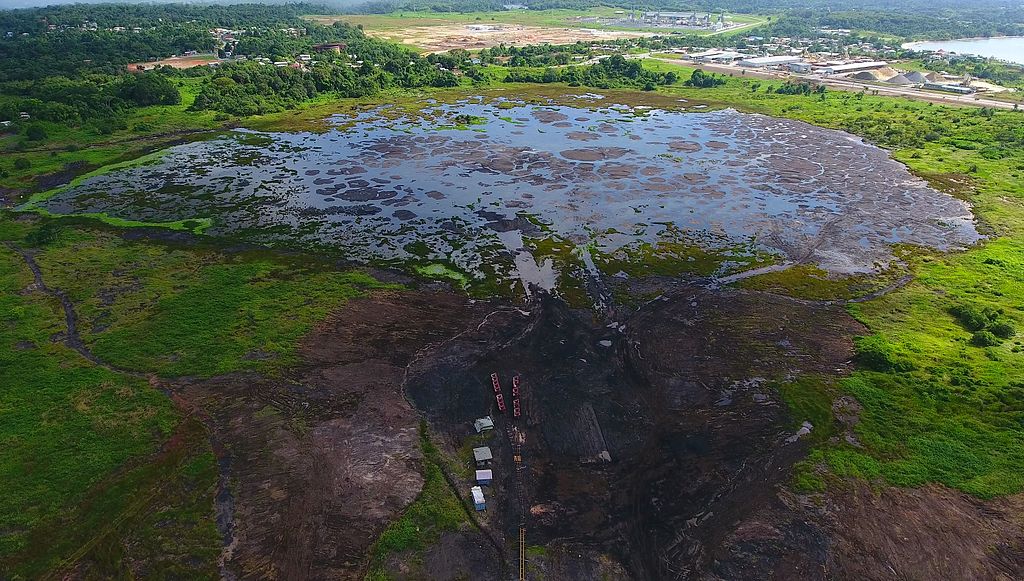
Lake Guanoco or Lake Bermudez is the second-largest asphalt lake in the world and is located in the Estato Sucre of Venezuela. The lake is 445 hectares (almost 1100 acres) and is between 4.9 and 6.6 feet (1.5-2 meters)deep. It is larger and purer than Pitch Lake, but not as deep.
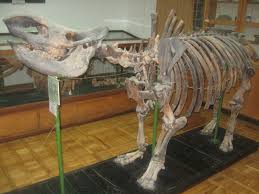
found in Azerbaijan’s Binagadi Asphalt Lake
Binagadi Asphalt Lake is located 7 km north of Baku, Azerbaijan, a country on the Caspian Sea. The bone-bearing area of the lake is 3.7 acres (1.5 hectares). According to UNESCO the Natural-Historical Museum claims to be “richer by number of Quaternary animal relics” than found California’s La Brea Tar Pits. It has found over 50,000 bones of various animals, but species numbers are 229 to La Brea’s 660 species from most current reports.
Animals found were giant cave hyenas that were bigger than today’s African lions, huge rhinoceros with 5- feet long tusks, elephants, and wolves. Large porcupines, primitive bulls, horses, oxen and deer were other animal bones found in this asphalt lake.
Peat Moss Bog “Mummies”
In the cold raised bogs of Northern Europe where poor drainage leads to ground saturated by acidic water with little oxygen content, bacteria could not survive, so decay slowed.
Humans were killed for mostly religious reasons and discarded into these bogs. The acid from the sphagnum or peat moss that grew in layers over the bodies which tanned the skin, nails, and hair. The skin became dark brown and leathery while the hair became a reddish-brown.
As the moss died, it releases a carbohydrate polymer called sphagnan which bound the nitrogen in the body and halted the growth of bacteria. Sphagnan also extracted the calcium in the bones which left the body as no more than a bag of leathery skin snd preserved organs after thousands of years.
Some of the bodies found date back to the Iron Age about 500 years B.C.E. Tne countries where bog mummies were found are Ireland, Denmark, England, Germany, and the Netherlands.
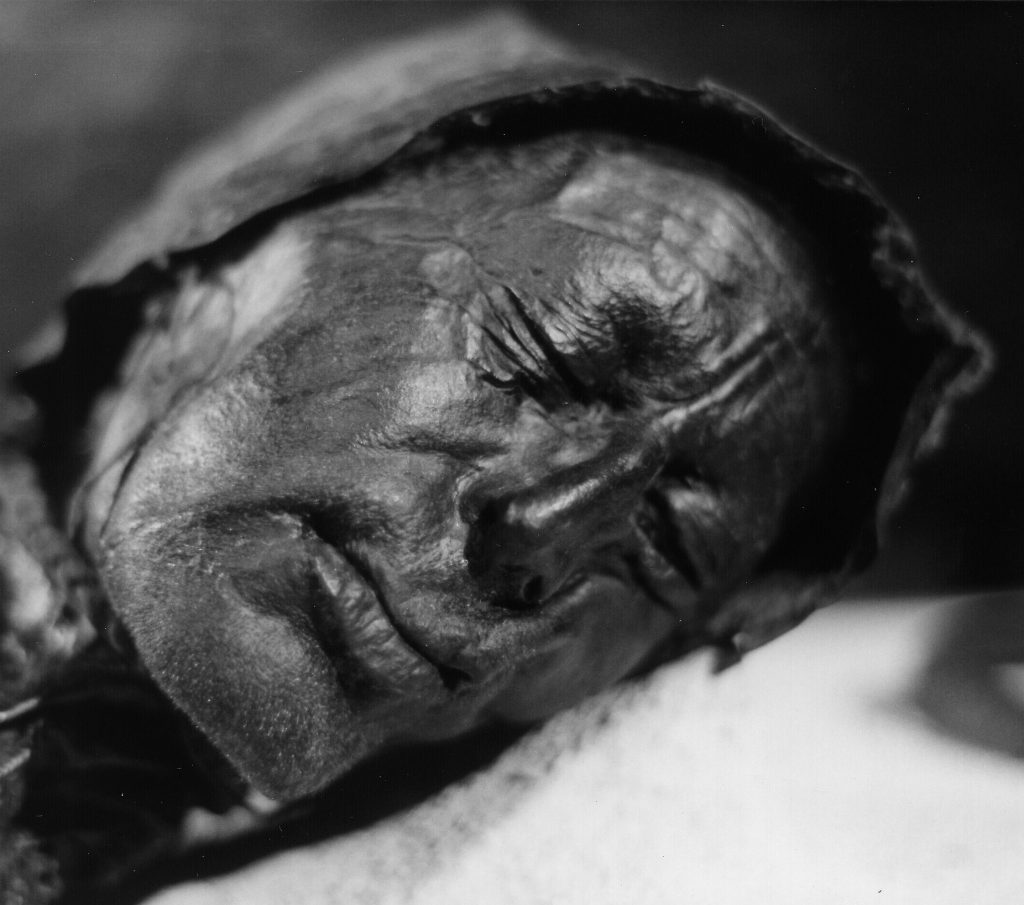
Image Credit- Wikimedia Commons- Public Domain
Florida has the Oldest Bog People Discovered Yet!
Titusville, Florida is the home of the largest, oldest, and well-preserved bog bodies and artifacts yet to be discovered! In 1982, a backhoe operator was clearing an area and came upon a human skull and bones. At first, thought to be an ancient crime scene, it was later found to contain 168 bodies of an old hunters and gatherers group of south Florida. The radiocarbon-dates ranged from 6,990-8,120 years ago plus or minus 70 years which were 4000 years older than Jesus Christ, older than ceramics, and 2000 years older than the pyramids of Egypt!
Called the Windover Archeological Burial Site, many artifacts such as children’s toys, a dog’s tooth-manatee rib hammer, and a deer antler hook for an atlatl. An atlatl is a launching device for a spear to send it farther and stronger toward the prey. It was used before the bow and arrow were developed.
The black peat bogs here had been forming since the last Ice Age about 11,000 years ago. What makes them so special is that there were crushed shells of snails and bivalves on the bottom of the bog that made the environment more alkaline. Less acid and more calcium carbonate and magnesium from the shells kept the bones of the bodies buried here more intact.
For more information visit: https://www.nbbd.com/godo/history/windover/index.html
